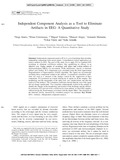Mostrar el registro sencillo del ítem
Independent component analysis as a tool to eliminate artifacts in EEG. A quantitative study
| dc.creator | Iriarte, Jorge | es_ES |
| dc.creator | Urrestarazu, Elena | es_ES |
| dc.creator | Valencia Ustárroz, Miguel | es_ES |
| dc.creator | Alegre, Manuel | es_ES |
| dc.creator | Malanda Trigueros, Armando | es_ES |
| dc.creator | Viteri, César | es_ES |
| dc.creator | Artieda, Julio | es_ES |
| dc.date.accessioned | 2017-08-18T10:39:25Z | |
| dc.date.available | 2017-08-18T10:39:25Z | |
| dc.date.issued | 2003 | |
| dc.identifier.citation | Independent Component Analysis as a Tool to Eliminate Artifacts in EEG: A Quantitative Study: Iriarte, Jorge; Urrestarazu, Elena; Valencia, Miguel; Alegre, Manuel; Malanda, Armando; Viteri, César; Artieda, Julio. Journal of Clinical Neurophysiology . 20(4):249-257, July/August 2003. | en |
| dc.identifier.issn | 0736-0258 (Print) | |
| dc.identifier.issn | 1537-1603 (Electronic) | |
| dc.identifier.uri | https://hdl.handle.net/2454/25198 | |
| dc.description.abstract | Independent component analysis (ICA) is a novel technique that calculates independent components from mixed signals. A hypothetical clinical application is to remove artifacts in EEG. The goal of this study was to apply ICA to standard EEG recordings to eliminate well-known artifacts, thus quantifying its efficacy in an objective way. Eighty samples of recordings with spikes and evident artifacts of electrocardiogram (EKG), eye movements, 50-Hz interference, muscle, or electrode artifact were studied. ICA components were calculated using the Joint Approximate Diagonalization of Eigen-matrices (JADE) algorithm. The signal was reconstructed excluding those components related to the artifacts. A normalized correlation coefficient was used as a measure of the changes caused by the suppression of these components. ICA produced an evident clearing-up of signals in all the samples. The morphology and the topography of the spike were very similar before and after the removal of the artifacts. The correlation coefficient showed that the rest of the signal did not change significantly. Two examiners independently looked at the samples to identify the changes in the morphology and location of the discharge and the artifacts. In conclusion, ICA proved to be a useful tool to clean artifacts in short EEG samples, without having the disadvantages associated with the digital filters. The distortion of the interictal activity measured by correlation analysis was minimal. | en |
| dc.description.sponsorship | This study was supported by the Government of Navarra, grants for research in Health 12/2003 and 15/2003. | en |
| dc.format.extent | 9 p. | |
| dc.format.mimetype | application/pdf | en |
| dc.language.iso | eng | en |
| dc.publisher | Lippincott, Williams & Wilkins | en |
| dc.relation.ispartof | Journal of Clinical Neurophysiology, 20 (4):249-257, July/August 2003 | en |
| dc.rights | © 2003 American Clinical Neurophysiology Society | en |
| dc.subject | EEG | en |
| dc.subject | Artifacts | en |
| dc.subject | Independent component analysis | en |
| dc.title | Independent component analysis as a tool to eliminate artifacts in EEG. A quantitative study | en |
| dc.type | Artículo / Artikulua | es |
| dc.type | info:eu-repo/semantics/article | en |
| dc.contributor.department | Ingeniería Eléctrica y Electrónica | es_ES |
| dc.contributor.department | Ingeniaritza Elektrikoa eta Elektronikoa | eu |
| dc.rights.accessRights | Acceso abierto / Sarbide irekia | es |
| dc.rights.accessRights | info:eu-repo/semantics/openAccess | en |
| dc.type.version | Versión aceptada / Onetsi den bertsioa | es |
| dc.type.version | info:eu-repo/semantics/acceptedVersion | en |


